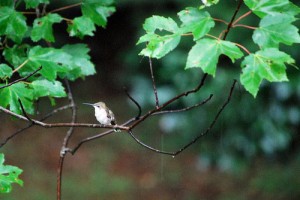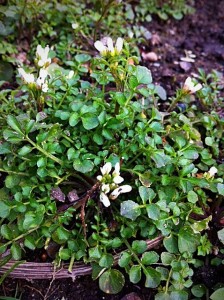Landscaping for wildlife – how to attract more birds, butterflies, and other little creatures
February 29, 2012 @ 4:14 pm

hummingbird; photo by lambatofa via Creative Commons License
Each morning, my son runs to the window to see what little creatures are feasting on seeds, nectar and berries in our front yard. Last week, we spotted a couple squirrels, a raccoon traipsing across our neighbor’s front yard, and several birds on the branches of our bare Japanese bloodgood maple). This week, we watched a couple hummingbirds flitter from branch to branch on the white-flowering currant that is getting ready to explode with its clusters of white flowers. Ribes sanguineum is one of our favorite plants in the Seattle landscape because of its spectacular white and red blooms are magnets for birds and butterflies.
Over the years as we have added to and edited our landscape in Seattle, we’ve added more shrubs and plants that can support wildlife. A typical neighborhood can hold more than 25 species of birds and mammals, such as hawks, raccoons, robins, chickadees, and even an occasional coyote, according to the Washington Department of Fish and Wildlife. You can design your Seattle landscape with wildlife in mind by providing creatures with four basic needs: food, water, shelter, and space. Bees, birds and butterflies feed on flower nectar; squirrels feast on nuts and berries. Have a variety of plants that flower at different times of the year so wildlife have a steady pick of food throughout the seasons. Insects are also an important food source for birds, so develop a high tolerance for bugs and avoid insecticides.
Trees and shrubs, brush piles, groundcovers and plants that grow at different heights provide creatures with various safe places to hide and rest. A good wildlife habitat has many levels of habitat, from the ground on up to the tallest evergreen. Plant groundcovers for bugs and taller trees like western hemlocks for woodpeckers and hawks.
Consider adding a water source for animals, such as a birdbath, stream or other fountain. The Humane Society recommends studying your yard from the viewpoint of an animal seeking shelter and food when you start gardening for wildlife. Learn the habits and tastes of the species you hope to attract, and identify any potential conflicts early enough to head them off before unacceptable damage has been done to your garden.
The National Wildlife Federation also offers tips on how to garden for wildlife and how to certify your landscape as a wildlife habitat. The Audubon Society has a website on Healthy Yards.
Contact Ecoyards if you’d like to redesign your landscape to attract more wildlife.
Filed under Seattle Landscape Design, Seattle Landscape Maintenance Permalink · No Comments »




